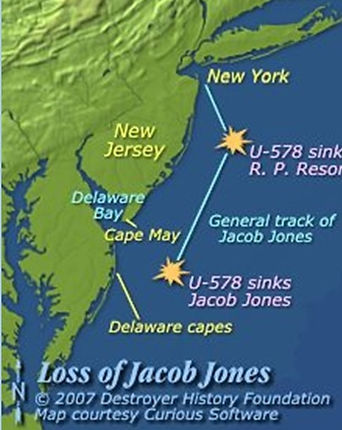
Destroyers
Destroyers
Prior to World War I
Britain and Germany were in an arms race. Both were trying to be the dominant naval power to control ocean trade. Their answer was to build dreadnought type battleships (Guns at least 12 inches and heavy armor). Along the way to dominance, they recognized that battleships had a vulnerability to submarines, small fast torpedo patrol boats, self propelled torpedoes and mines. Merchant Marine ships carrying troops and war goods were also vulnerable. American Navy added to its Battleships (about 450 to 550 feet long) a fleet of smaller (about 300 feet) ocean going destroyer torpedoes boats to protect the capital ships and convoys of merchant ships.
New York shipyard had produced 9 destroyers before the end of WWI. All participated in the war and survived except one, USS Jacob Jones DD61 torpedoed near Ireland and sank with loss of life. USS Preston DD19 (1909) was the last destroyer to use coal as its energy source. All other destroyers were oil fired and steam turbine driven.

German Battleship SMS Helgoland; Capital ship of the period

USS Jacob Jones (DD-61), 315 feet long; Sunk December 1917, near Ireland
Destroyer Yard at New York Shipyard in WWI

Destroyer Yard at New York Shipyard
The Navy ordered more than 250 destroyers from various shipyards across the country. New York shipyard received an order for 30 destroyers in 1917. The order required building additional ship ways south of the original covered ship ways. They were known as four stackers because of the arrangement of smoke stacks. All were completed too late for service in WWI. All saw service after the war, most were laid up sometime in the post war period then reactivated for WWII. Some were modified for various services. Most survived through WWII except as noted below:
Rubin James DD 245 (1920) – Before Germany declared war in 1941, U-552 sank the destroyer while on convoy escort duty. U-552 is the same submarine that sank the tanker “Coimbra” just south of Long Island (January 1942).

USS Barry DD-248 (1920) – later converted to APD-29. Damaged by kamikaze attack off Okinawa May 1945. Damaged beyond economical repair.

Jacob Jones DD130 (1919) - Off the New Jersey coast the tanker “RP Resor” was torpedoed by a German submarine in February 1942. The ship caught fire and sank. Jacob Jones was ordered to look for survivors and any submarines skulking about. The destroyer did not find survivors and was torpedoed by U-578. The destroyer sank in 45 minutes and only 12 of the crew survived.

Jacob Jones DD130 (1919)

USS Delong DD-129 (1919) – Ran aground in fog in Half Moon Bay, California (1922). Damaged beyond economical repair.
USS Sturevant DD-240 (1920) – Sunk by an American mine off Key West Florida due to poor communication about where the minefield was located (1942).




